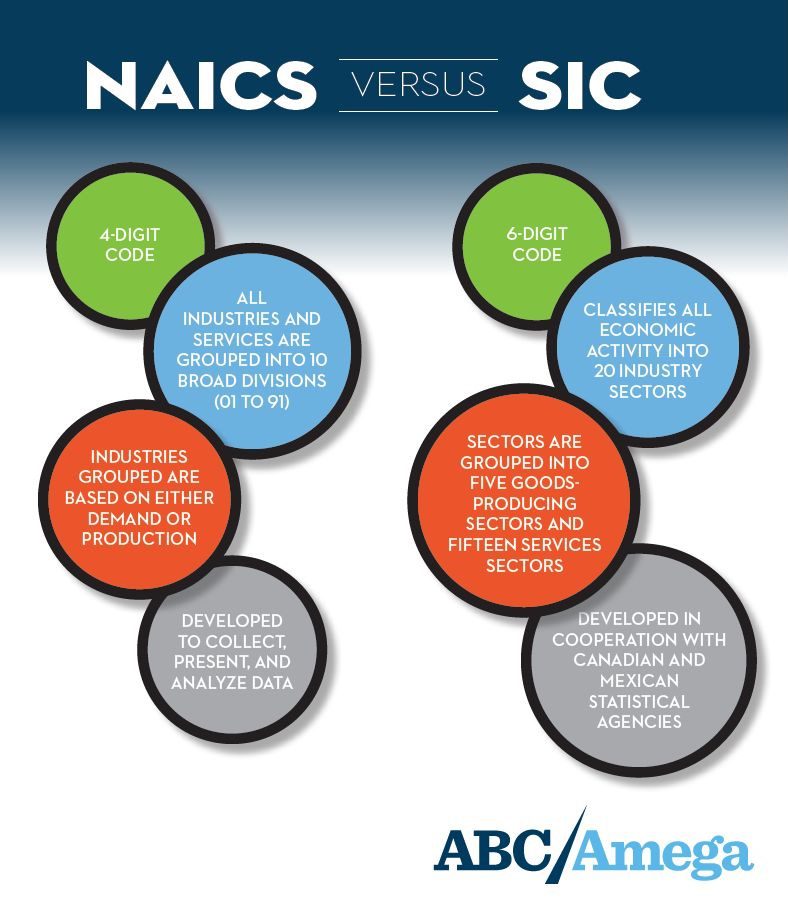Eating Places: 5812
Full-Service Restaurant: 722511
Stationery and Office Supplies: 5112
Office Supplies and Stationary Stores: 45321
Retail Nurseries, Lawn and Garden Supply Stores: 5261
Lawn and Garden Equipment and Supplies Stores: 4442
Can you decipher which of these codes are SIC industry classifications versus which are NAICS (pronounced ‘nakes’) codes? If your company is in one of these industry classifications, how do you know which code to use?
Though the North American Industry Classification System (NAICS) officially replaced the Standard Industrial Classification (SIC) code system in 1997, both systems are still in use today and there is still confusion about which code to use and when to use it.
In an effort to shed some light on these perplexing systems, let’s explore why each was developed, how they were used historically and how each classification system is used today.
What are SIC and NAICS codes?
Both SIC and NAICS codes identify a firm’s primary business function. As in the examples given above, the numeric codes differ per industry and differ between the two systems. For example, a furniture retailer’s SIC code may be 5712, while their NAICS code is 442110. These codes were developed by the federal government and are used by the U.S. Office of Management and Budget (OMB) as well as many other U.S. statistical agencies.
SIC and NAICS Code History
According to the U.S. Census Bureau, the SIC system originated from a recommendation at an Interdepartmental Conference on Industrial Classification held in 1934. The thought was that there needed to be a system to classify U.S. businesses based on the company’s primary activity as well as to measure and compare financial activity between similar organizations. This recommendation was communicated to the Central Statistical Board and with years of further thought, committee creation and process development, the first edition of the Standard Industrial Classification Manual was put out in duplicated form in 1939.
After the 1939 Standard Industrial Classification had been used for a reasonable length of time, it was decided that it should be reviewed, and appropriate revisions were made. The project was sponsored by the Bureau of the Budget, to which the Central Statistical Board had been transferred. Following the review, the first printed edition of Manufacturing Industries was published in 1941 and that of Nonmanufacturing Industries in 1942.
SIC code numbers, which can be up to four digits, were last updated in 1987 by the Office of Management and Budget, and in 1997, OMB assumed NAICS as its new industry classification system. According to the U.S. Census Bureau, six-digit NAICS classifications provide more flexibility than SIC codes; and they are also designed to provide compatibility and comparison capabilities among industries in Canada, Mexico and the United States. While SIC codes are still used by some organizations and government agencies for non-statistical purposes, NAICS numbers are the standard for federal economic study applications.
What is the difference between SIC and NAICS codes?
The SIC groups all forms of industry and services into ten broad divisions (01 to 91). The original code had only four digits: the broad division represented by the first two digits; the industry group and type represented by the last two digits. (e.g. Book printing is classified under SIC 2732. “27” represents Printing and Publishing, and “32” represents “Book printing”.)
NAICS classifies all economic activity into twenty industry sectors: five goods-producing sectors and fifteen services sectors; and it uses a six-digit code. Digits 1 and 2 designate the largest/main business sector; digit 3 the subsector; digit 4 the industry group; digit 5 the specific industry; and digit 6 is a country specific number for U.S., Canadian or Mexican industry-specific designation.
NAICS is an industry classification system, not a product classification system. Organizations are grouped into industries based upon the likeness of the process used to generate goods or services. Additionally, NAICS codes are based on stable, economic models, while SIC codes are not. Therefore, with NAICS codes, establishments that use the same or similar processes to produce goods or services are grouped together. Industries under the SIC codes were grouped together based on either demand or production.
While created for statistical purposes, the NAICS is also used for administrative, regulatory, contracting, taxation and other non-statistical purposes. Some state governments, for example, offer tax incentives to companies classified in specific NAICS industries.
Unlike SIC codes, NAICS codes were developed in cooperation with Canadian and Mexican statistical agencies. Because both Canada and Mexico use NAICS for their industry classifications, government and business analysts can directly compare industrial production statistics collected and published in the three North American Free Trade Agreement countries. Additionally, NAICS provides for increased comparability with the International Standard Industrial Classification (ISIC) system, developed and maintained by the United Nations.

NAICS vs. SIC
Which code is better to use?
Many resources use only NAICS or only SIC codes, so it is important to have both the NAICS codes and SIC codes when doing business research. For example, the SIC code is still used by some federal departments, state and local governments, as well as credit reporting companies and list providers.
However, SIC codes were not able to keep up with current industries, and as a result of the development of the North American Industry Classification System, more than 350 new industries were recognized.
Can historical SIC data be compared with current NAICS data?
No. SIC codes do not directly convert to NAICS codes – a firm that may have fallen under a particular SIC code may now be classified under a completely different NAICS code. For example, a company classified in SIC 7359 Business Services (Not Elsewhere Classified) may now be classified under NAICS 491110 Postal Service, or NAICS 541340 Drafting Services, among others.
Other Industry Classification Systems
In addition to the SIC, NAICS, and ISIC classification systems, there are numerous other nation-based and organization-based systems. For instance, the SEMI® Industry Classification System is a product classification system for the suppliers that support the various industry segments represented by the SEMI® Trade Association. The Global Industry Classification Standard (GICS) is the industry classification structure used for Standard & Poor’s U.S. industry index calculations.
Check out these other Business Operations articles on our website.
Learn about how our commercial collection agency can help your business by contacting us at 844.937.3268 today!
